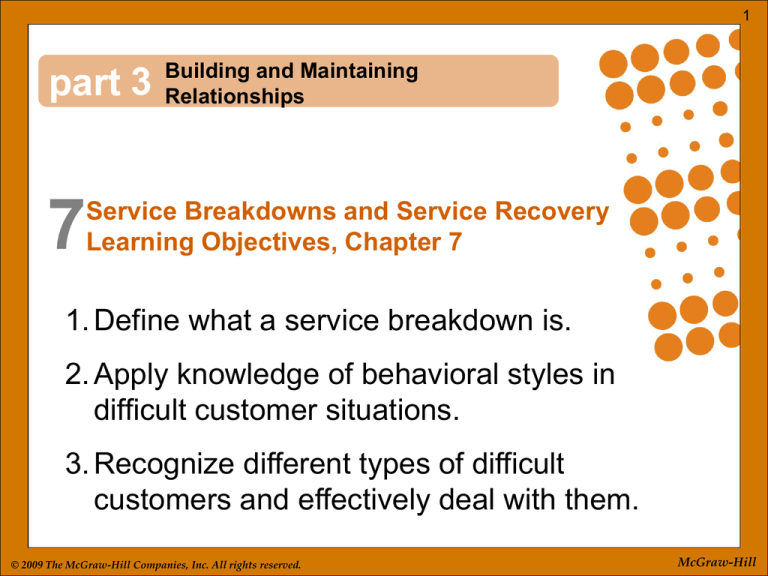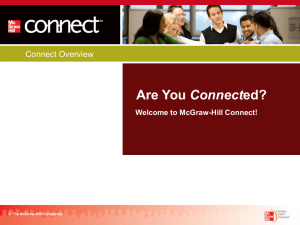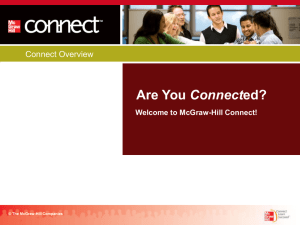
1
part 3
Building and Maintaining
Relationships
7
Service Breakdowns and Service Recovery
Learning Objectives, Chapter 7
1. Define what a service breakdown is.
2. Apply knowledge of behavioral styles in
difficult customer situations.
3. Recognize different types of difficult
customers and effectively deal with them.
© 2009 The McGraw-Hill Companies, Inc. All rights reserved.
McGraw-Hill
2
Service Breakdowns and Service
Recovery Learning Objectives,
Continued
4. Use the emotion-reducing model to help keep
difficult situations from escalating.
5. Explain why customers defect.
6. Develop effective strategies for working with
internal customers.
McGraw-Hill
© 2009 The McGraw-Hill Companies, Inc. All rights reserved.
3
Service Breakdowns and Service
Recovery Learning Objectives,
Continued
7. Identify strategies for preventing customer
dissatisfaction and problem solving.
8. Explain the six steps of the problem solving
model.
9. Implement a front-line service recovery
strategy, and spot roadblocks to service
recovery.
McGraw-Hill
© 2009 The McGraw-Hill Companies, Inc. All rights reserved.
4
Understand Service Breakdowns:
What are service breakdowns?
Service breakdowns occur daily in all
types of organizations.
Definition:
Situation when customers have expectations of a
certain type or level of service that
are not met by a service representative.
McGraw-Hill
© 2009 The McGraw-Hill Companies, Inc. All rights reserved.
5
Behavioral Preferences Play
a Major Role
The Role of Behavioral Style
The more you know about style preferences,
the better you will understand your customers.
See Ch. 6 to review the behavioral preferences
if you have need to confirm their
patterns and strategies for dealing with
them.
McGraw-Hill
© 2009 The McGraw-Hill Companies, Inc. All rights reserved.
6
Difficult Customers
Various types of difficult customers will
be faced.
Demanding or demeaning
Be professional, respect the customer, be firm
and fair. Say what you can do.
Indecisive customers
Be patient, ask open-ended questions, listen
actively, suggest options, guide decision making
McGraw-Hill
© 2009 The McGraw-Hill Companies, Inc. All rights reserved.
7
Difficult Customers, continued
Other types of difficult customers
Dissatisfied and angry customers.
Be positive, acknowledge customer’s feelings,
reassure, remain objective, listen actively,
reduce frustrations, negotiate solutions and
follow up.
Rude or inconsiderate customers.
Remain professional.
Don’t retaliate.
McGraw-Hill
© 2009 The McGraw-Hill Companies, Inc. All rights reserved.
8
Talkative Customers
Tips for dealing with talkative customers
Remain warm and cordial, but focused
Ask specific open-ended questions.
Use closed-end questions to control.
Manage the conversation.
McGraw-Hill
© 2009 The McGraw-Hill Companies, Inc. All rights reserved.
9
The Emotion-Reducing Model
Review each area of the model. Use
the model for reducing customer emotions.
McGraw-Hill
© 2009 The McGraw-Hill Companies, Inc. All rights reserved.
10
Customer Defection
Reasons to Defect
• Poor service and complacency.
• Inappropriate complaint resolution.
• Unmet needs.
Failure to be sensitive to diversity may set you,
your company, and your customer on a collision
course.
McGraw-Hill
© 2009 The McGraw-Hill Companies, Inc. All rights reserved.
11
Internal Customer Relations
Relationships—Internal customers are special
also
• Stay connected
• Meet all commitments
• Don’t sit on your emotions
• Build a professional reputation
• Adopt a good-neighbor policy
McGraw-Hill
© 2009 The McGraw-Hill Companies, Inc. All rights reserved.
12
Strategies to Prevent
Dissatisfaction:
Use problem solving
Ways to deal with a service breakdown
is to prevent it:
Think like a customer
Pamper the customer
Focus on the customer
McGraw-Hill
Exceed expectations
Respect the customer
© 2009 The McGraw-Hill Companies, Inc. All rights reserved.
13
Prevent Dissatisfaction:
Focus on the Customer
Take the following actions to focus on
the customer:
React to remarks or actions.
Empathize.
Take action.
Reassure or reaffirm.
Follow-up.
McGraw-Hill
© 2009 The McGraw-Hill Companies, Inc. All rights reserved.
14
The Problem-Solving Process
Steps to Problem Solving
McGraw-Hill
© 2009 The McGraw-Hill Companies, Inc. All rights reserved.
15
Implementing a Service
Recovery Strategy
The five phases of the service recovery
process are:
1.
2.
3.
4.
5.
McGraw-Hill
Apologize, apologize, apologize again.
Take immediate action.
Show compassion.
Provide compensation.
Conduct follow up.
© 2009 The McGraw-Hill Companies, Inc. All rights reserved.
16
Service Recovery Process,
Fig. 7.7
Use the form to format the discussion easier
McGraw-Hill
© 2009 The McGraw-Hill Companies, Inc. All rights reserved.
17
Examples of Service Breakdowns
Review each with an eye to solving
the problem.
McGraw-Hill
© 2009 The McGraw-Hill Companies, Inc. All rights reserved.










